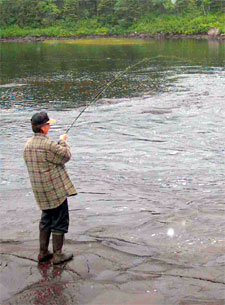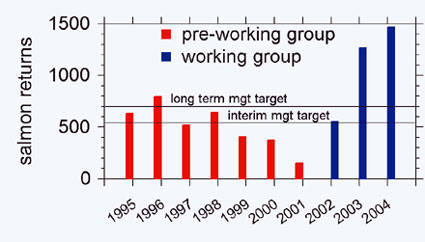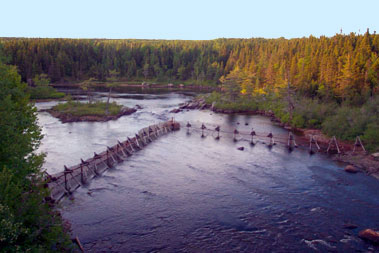page3
Community stewardship reverses steady decline of salmon stock in Terra Nova National Park of Canada
Local residents have a renewed sense of pride in the beautiful and productive Northwest River
Located on the eastern coast of Newfoundland, where the boreal landscape meets Atlantic fiords, Terra Nova National Park of Canada is the country's most easterly national park. The Northwest River, near the eastern boundary of Terra Nova, is a beautiful, rugged river that is popular with kayakers and anglers. It flows over 60 kilometres from its headwaters in the Bay du Nord Wilderness Area, through open, barren country and cascading falls before emptying into the Atlantic Ocean in Terra Nova National Park. For generations, local community residents have enjoyed angling for salmon on the Northwest.
However, by the mid-1990s, the salmon stock in the Northwest River was at risk. Declining numbers of salmon returning to Newfoundland's rivers forced the commercial salmon fishery to close in 1992, but stock levels in the Northwest River failed to substantially improve. To protect the remaining salmon, Parks Canada closed the Northwest River to recreational salmon fishing in 1996. A fish-counting fence showed that, despite stopping all fishing, the number of returning salmon still continued to decline. The problem was illegal fishing.
 Man fishing © Parks Canada / M. Langdon / 2004 |
Traditional solutions clearly weren't working, so in 2002, Parks Canada joined with the Department of Fisheries and Oceans and local residents to try a new approach. Together, they formed the Northwest River Atlantic Salmon Conservation Working Group. Led by two local citizens, this advisory group supported a population recovery and conservation plan. Community stewardship was key to the plan. Recreational fishing could resume only if enough fish to ensure the future health of the stock passed through the counting fence. Each salmon caught illegally reduced the likelihood that the river would reopen for angling, threatening the goal desired by the community.
The advisory group set short- and long-term goals to recover the stock, determining the minimum number of spawners needed to sustain the population. The group then calculated how many salmon could safely be harvested. After those targets were met, Parks Canada reopened the Northwest River to anglers in summer 2003. In subsequent years, this same management process has been applied.
 Table depicting salmon returns © Parks Canada / M. Langdon / 2004 |
Through their partnership with Parks Canada, residents now have a meaningful role in managing their local resources. Community pride in this local river system has been renewed. As well, the number of salmon returning to the Northwest River continues to climb.
Results
- In 2001, the Northwest River was Newfoundland's poorest performing river, with only 152 spawners. By 2003, it had become the best, with over 1,200 returning salmon.
- One year after the formation of the Northwest River Atlantic Salmon Conservation Working Group, returning salmon exceeded the goal of 550 spawners by over 100%.
- In 2004, 1,472 salmon were counted.the highest number since the counting fence was installed in 1995.
 Counting fence in a river © Parks Canada / D. Coté / 2004 |
- Date modified :